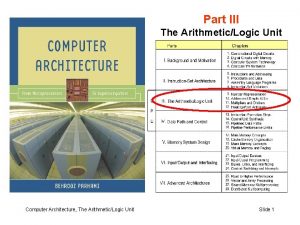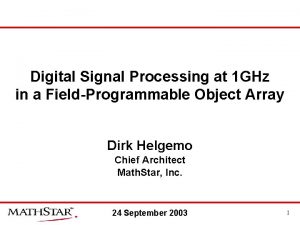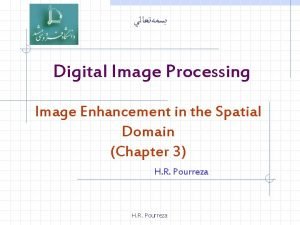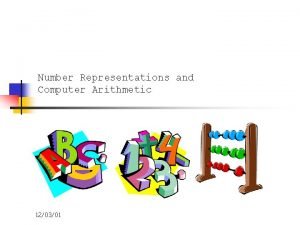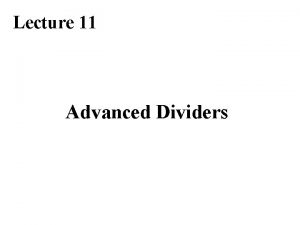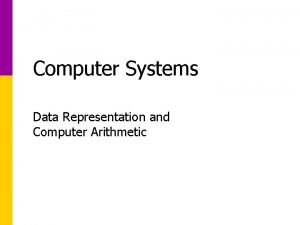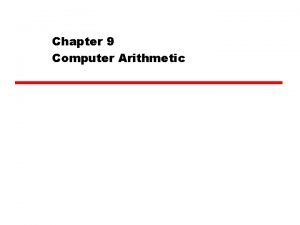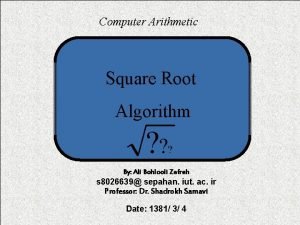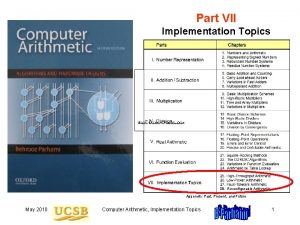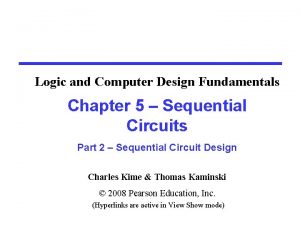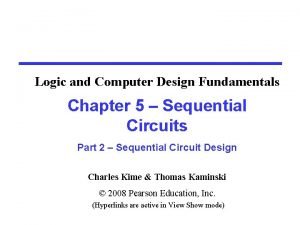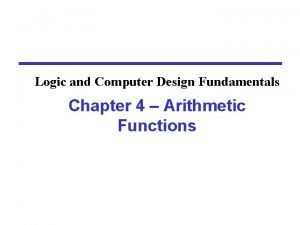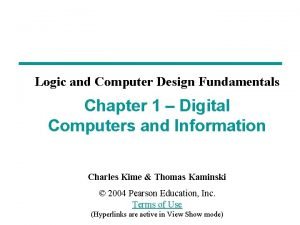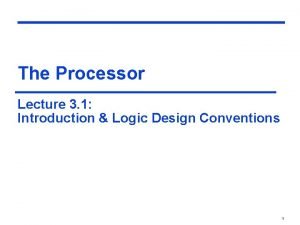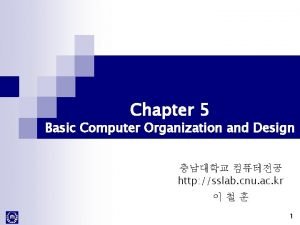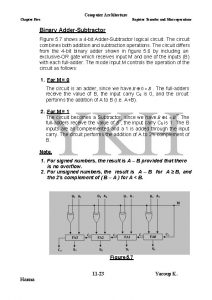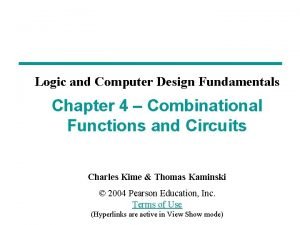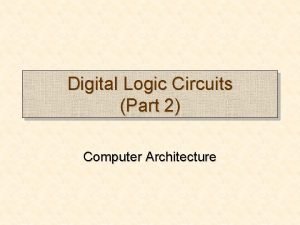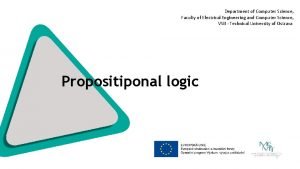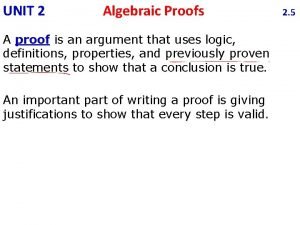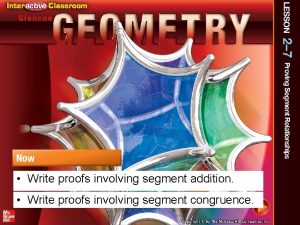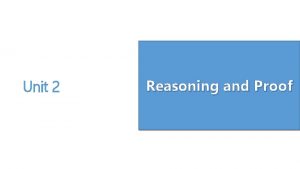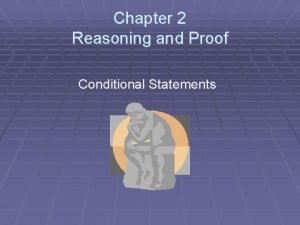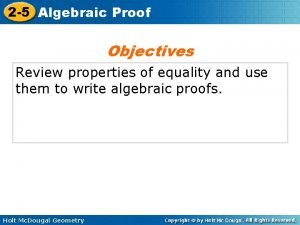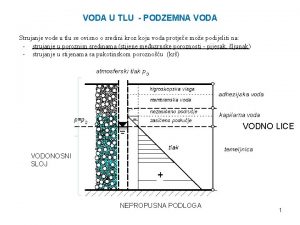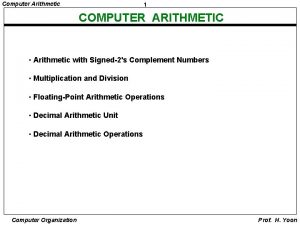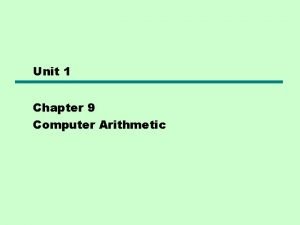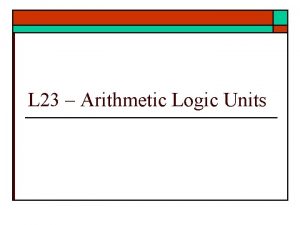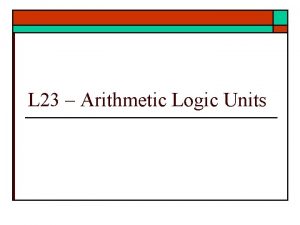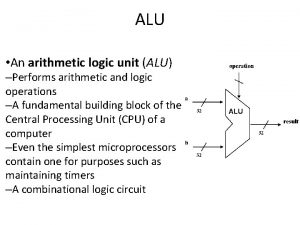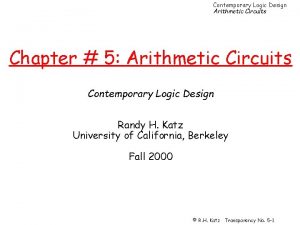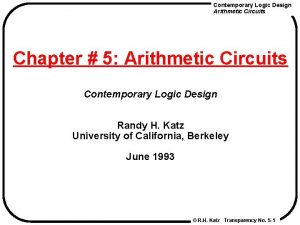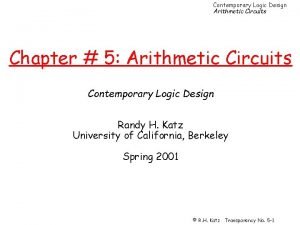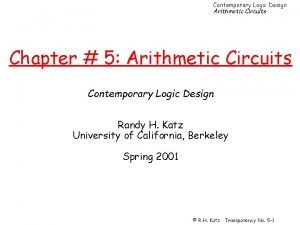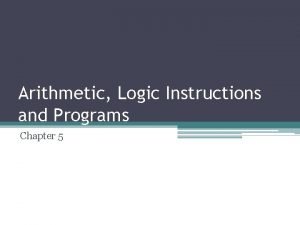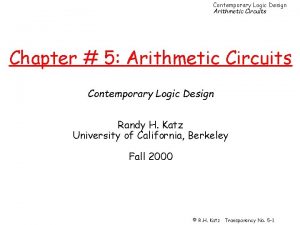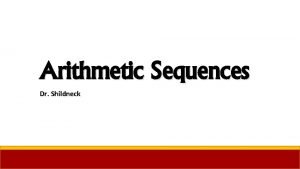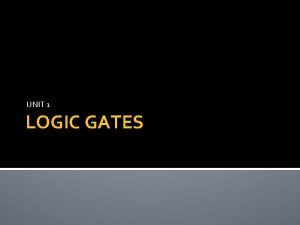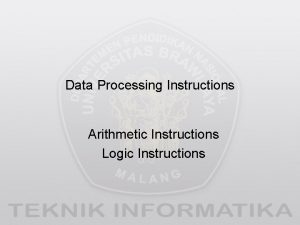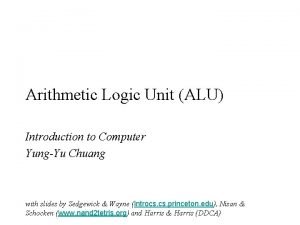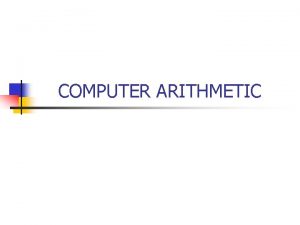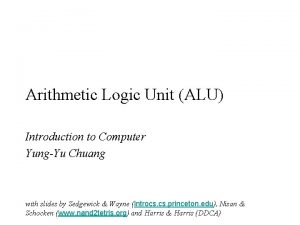Chapter 9 Computer Arithmetic Arithmetic Logic Unit Does







































- Slides: 39

Chapter 9 Computer Arithmetic

Arithmetic & Logic Unit • Does the calculations • Everything else in the computer is there to service this unit • Handles integers • May handle floating point (real) numbers • May be separate FPU (maths coprocessor) • May be on chip separate FPU (486 DX +)

ALU Inputs and Outputs

Integer Representation • Only have 0 & 1 to represent everything • Positive numbers stored in binary —e. g. 41=00101001 • • No minus sign No period Sign-Magnitude Two’s complement

Sign-Magnitude • • • Left most bit is sign bit 0 means positive 1 means negative +18 = 00010010 -18 = 10010010 Problems —Need to consider both sign and magnitude in arithmetic —Two representations of zero (+0 and -0)

Two’s Complement • • +3 +2 +1 +0 -1 -2 -3 = = = = 00000011 00000010 00000001 0000 11111110 11111101

Benefits • One representation of zero • Arithmetic works easily (see later) • Negating is fairly easy — 3 = 00000011 —Boolean complement gives —Add 1 to LSB 11111100 11111101 -3

Geometric Depiction of Twos Complement Integers

Negation Special Case 1 • • • 0= 0000 Bitwise not 1111 Add 1 to LSB +1 Result 1 0000 Overflow is ignored, so: -0=0

Negation Special Case 2 • • -128 = 10000000 bitwise not 01111111 Add 1 to LSB +1 Result 10000000 So: 최대표현양수: 127 ! -(-128) = -128 X Monitor MSB (sign bit) It should change during negation

Range of Numbers • 8 bit 2 s complement +127 = 01111111 = 27 -1 -128 = 10000000 = -27 • 16 bit 2 s complement +32767 = 01111111 = 215 - 1 -32768 = 10000000 = -215

Conversion Between Lengths • • Positive number pack with leading zeros +18 = 00010010 +18 = 0000 00010010 Negative numbers pack with leading ones -18 = 1110 -18 = 1111 1110 i. e. pack with MSB (sign bit)

Addition and Subtraction • Normal binary addition • Monitor sign bit for overflow • Take two’s complement of subtrahend (b) and add to minuend (a) —i. e. a - b = a + (-b) • So we only need addition and complement circuits

Hardware for Addition and Subtraction

Multiplication • • Complex Work out partial product for each digit Take care with place value (column) Add partial products

Multiplication Example • 1011 Multiplicand (11 dec) • x 1101 Multiplier (13 dec) • 1011 Partial products • 0000 Note: if multiplier bit is 1 copy • 1011 multiplicand (place value) • 1011 otherwise zero • 10001111 Product (143 dec) • Note: need double length result

Unsigned Binary Multiplication Q (Multiplier) M (Multiplicand) C || A || Q (for partial product. Therefore, the multiplication results)

M(Multiplicand) Q (Multiplier) Execution of Example If Q 0 ==1 then Add and Shift else only Shift Partial product multiplier multiplicand A A+M A=A+M 0010 + 1011 {C||A||Q} >> 1

Flowchart for Unsigned Binary Multiplication

Multiplying Negative Numbers • This does not work! • Solution 1 —Convert to positive if required —Multiply as above —If signs were different, negate answer • Solution 2 —Booth’s algorithm

Booth’s Algorithm We should check every two consecutive bits in Multiplier at a time: Q 0 Q-1 - Q 0 operations 0 0 0 No operations 1 0 -1 Subtract M from partial product 1 1 0 No operations 0 1 1 Add M to partial product Booth's Algorithm for Twos Complement Multiplication

Example of Booth’s Algorithm (7 X 3) 1 0 : A = A-M, and then shift; * 0000 + 1001 (2’s) = 1001 1 1 : just shift; 0 1: A = A+M, and then shift; * 1110 + 0111 = 0101 0 0: just shift;

Division • More complex than multiplication • Negative numbers are really bad! • Based on long division

Division of Unsigned Binary Integers 00001101 1011 10010011 Divisor 1011 001110 Partial 1011 Remainders 001111 100 Quotient Dividend Remainder

Flowchart for Unsigned Binary Division

Real Numbers • Numbers with fractions • Could be done in pure binary — 1001. 1010 = 23 + 20 +2 -1 + 2 -3 =9. 625 • Where is the binary point? (vs. decimal point) • Fixed? —Very limited • Moving? —How do you show where it is?

Floating Point Significand = mantissa = coefficient • +/-. significand x 2 exponent • Point is actually fixed between sign bit and body of mantissa • Exponent indicates place value (point position)

Floating Point Examples Excess 127로 표현함 (-20)에 127을 더한 값 (Excess 127) bias value 20 bias value -20 No two’s complement 20

Signs for Floating Point • Negative Mantissa is not expressed as 2 s complement • Exponent is in excess or biased notation —e. g. Excess (bias) 127 means — 8 bit exponent field —Pure value range 0 -255 —Subtract 127 to get correct value —Range -127 to +128 (excess 127)

Normalization • FP numbers are usually normalized • i. e. exponent is adjusted so that leading bit (MSB) of mantissa is 1 • Since it is always 1 there is no need to store it • (c. f. Scientific notation where numbers are normalized to give a single digit before the decimal point • e. g. 3. 123 x 103)

FP Ranges • For a 32 bit number — 8 bit exponent —+/- 2256 1. 5 x 1077 • Accuracy —The effect of changing lsb of mantissa — 23 bit mantissa 2 -23 1. 2 x 10 -7 —About 6 decimal places

Expressible Numbers (in typical 32 -bit format) 8 bit exponent -2 -127 ~2128 23 bit mantissa 2 -23 0. 1 2 -1 0. 01 2 -2 0. 001 2 -3 소수점 23번 째자리 2 -2 -1 1. 1 2 -2 -2 1. 11 … 2 -2 -23 1. 11111…. 1

Density of Floating Point Numbers • The numbers represented in floating-point notation are not spaced evenly along the number line, as are fixed-point numbers • The possible values get closer together near the origin and farther apart as you move away.

IEEE 754 • • Standard for floating point storage 32 and 64 bit standards 8 and 11 bit exponent respectively Extended formats (both mantissa and exponent) for intermediate results

IEEE 754 Formats

IEEE 754 Formats

FP Arithmetic •

FP Arithmetic +/- • • Check for zeros Align significands (adjusting exponents) Add or subtract significands Normalize result

FP Addition & Subtraction Flowchart
 Fetch routine
Fetch routine Arithmetic logic unit
Arithmetic logic unit Arithmetic logic unit
Arithmetic logic unit The objective of sharpening spatial filter is to
The objective of sharpening spatial filter is to First order logic vs propositional logic
First order logic vs propositional logic First order logic vs propositional logic
First order logic vs propositional logic First order logic vs propositional logic
First order logic vs propositional logic Combinational logic vs sequential logic
Combinational logic vs sequential logic Tw
Tw 캠블리 단점
캠블리 단점 Is it x y or y x
Is it x y or y x Combinational logic sequential logic 차이
Combinational logic sequential logic 차이 Combinational logic sequential logic
Combinational logic sequential logic Unit 6 review questions
Unit 6 review questions Computer arithmetic: algorithms and hardware designs
Computer arithmetic: algorithms and hardware designs Computer arithmetic
Computer arithmetic Behrooz parhami computer arithmetic
Behrooz parhami computer arithmetic Data representation and computer arithmetic
Data representation and computer arithmetic Fixed point addition and subtraction flowchart
Fixed point addition and subtraction flowchart Square root algorithm
Square root algorithm Computer organization and architecture william stallings
Computer organization and architecture william stallings Computer arithmetic
Computer arithmetic Jk flip flop
Jk flip flop Logic and computer design fundamentals
Logic and computer design fundamentals Logic and computer design fundamentals
Logic and computer design fundamentals Logic and computer design fundamentals
Logic and computer design fundamentals Logic design conventions
Logic design conventions Flowchart for memory reference instructions
Flowchart for memory reference instructions Logic microoperations in computer architecture
Logic microoperations in computer architecture Logic & computer design fundamentals
Logic & computer design fundamentals Digital logic and computer architecture
Digital logic and computer architecture Computer logic
Computer logic Threshold logic unit in neural network
Threshold logic unit in neural network Unit 2 logic and proof homework 6 algebraic proof
Unit 2 logic and proof homework 6 algebraic proof Segment addition postulate proof
Segment addition postulate proof Unit 2 logic and proof inductive reasoning
Unit 2 logic and proof inductive reasoning Proving conditional statements
Proving conditional statements Direct algebraic proof
Direct algebraic proof Darcyev zakon
Darcyev zakon Physiological density
Physiological density

